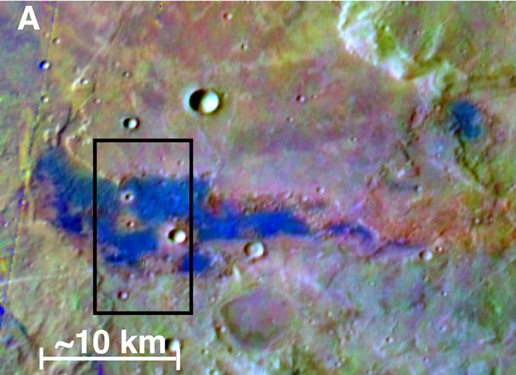Multimedia Features
Chloride Salt Deposit in Southern Highlands of Mars
03.20.08

+ Larger image
+ High resolution - annotated (5.7 Mb)
+ High resolution - no annotation (5.7 Mb)
Bright blue marks a deposit of chloride (salt) minerals in the southern highlands of Mars in this false-color image, which highlights mineral composition differences. The Thermal Emission Imaging System (THEMIS) camera on NASA's Mars Odyssey orbiter made this observation. Researchers using THEMIS reported in March 2008 that they have found about 200 such deposits of chloride salts. Observations by THEMIS and other instruments orbiting Mars indicate that these deposits typically lie within topographic depressions. The salt deposits suggest that Mars was much wetter long ago. They point to places where water was once abundant, then evaporated, leaving the minerals behind.
This site lies at about 221 degrees east longitude and 38.8 degrees south latitude, within the rugged Terra Sirenum region of Mars. The view is a portion of an image taken by THEMIS on Dec. 11, 2003. The full image is at http://themis-data.asu.edu/img/I08831002?tab=1 .
The scale bar is about 10 kilometers (6.2 miles). The black rectangle indicates the outline of a higher resolution view, available as PIA10248.
NASA's Jet Propulsion Laboratory, a division of the California Institute of Technology, Pasadena, manages the Mars Odyssey mission for the NASA Science Mission Directorate, Washington. The Thermal Emission Imaging System (THEMIS) was developed by Arizona State University, Tempe, in collaboration with Raytheon Santa Barbara Remote Sensing. Lockheed Martin Space Systems, Denver, is the prime contractor for the Odyssey project, and developed and built the orbiter.
Image Credit: NASA/JPL-Caltech/Arizona State University/University of Hawaii